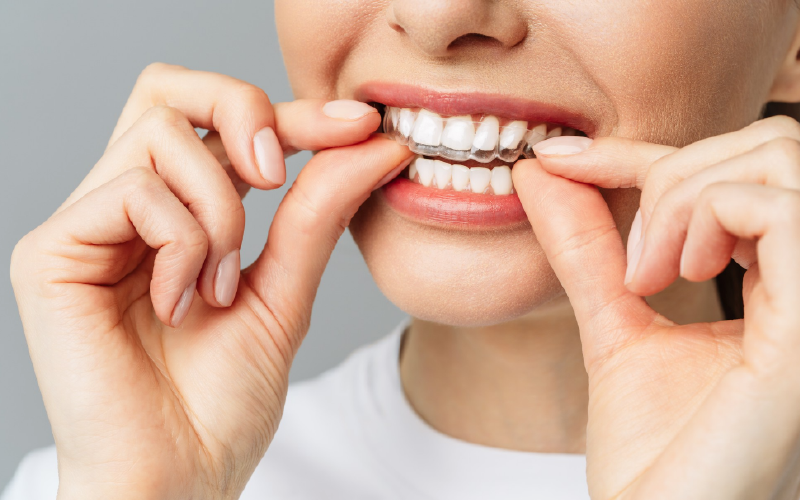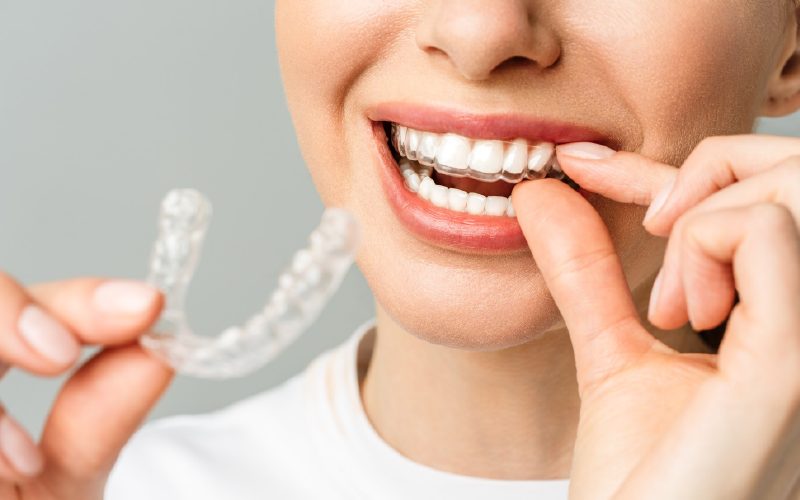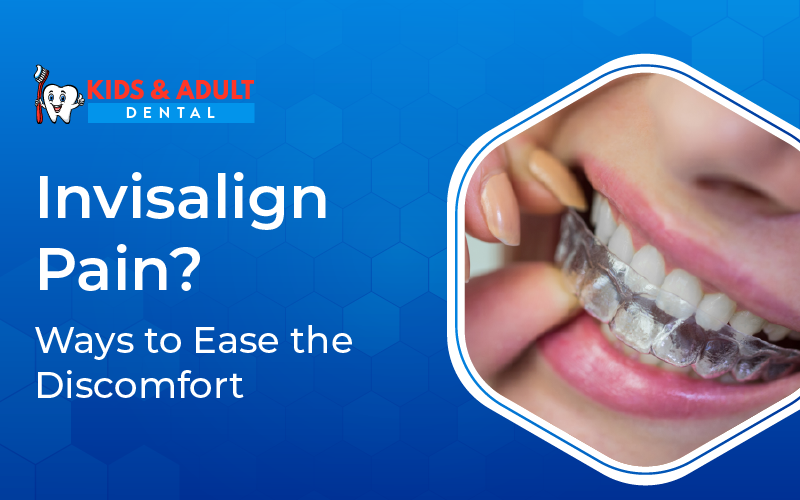Invisalign treatment has revolutionized the field of orthodontics, offering a discreet and effective solution for achieving straighter and healthier smiles. Unlike traditional braces, Invisalign uses a series of clear, removable aligners that gradually shift teeth into their desired position.
This innovative approach has transformed the orthodontic experience for millions of individuals, providing them with a more comfortable and aesthetically pleasing alternative.
The Common Challenge: Managing Pain During Treatment

While Invisalign offers numerous advantages, it’s important to acknowledge that some patients may experience temporary discomfort or pain during the treatment process.
This pain can arise due to the pressure exerted by the aligners as they gently move the teeth into alignment. While the pain is typically manageable, it can be a source of concern and may require proactive measures to ensure a smooth and comfortable treatment journey.
By understanding and implementing effective pain management strategies, patients can navigate through this common challenge and achieve the desired results while minimizing discomfort.
In the following sections, we will explore essential tips and techniques to help individuals effectively manage and alleviate Invisalign treatment pain, ensuring a more pleasant orthodontic experience.
What Causes Pain During Invisalign Treatment?
1. Aligner Tightening

When you progress to a new set of aligners, they may feel tight as they apply pressure to gradually move your teeth. This pressure can cause temporary discomfort or soreness.
2. Teeth Movement
As your teeth are being guided into their new positions, the ligaments and tissues supporting them are stretched and adjusted. This movement can lead to some level of pain or discomfort.
3. Aligner Irritation

Occasionally, the aligners may rub against the gums, tongue, or cheeks, causing irritation or sore spots. This can result in localized pain or discomfort.
In some cases, attachments or buttons may be added to your teeth to facilitate more precise movement. These small, tooth-colored bumps or hooks can create additional pressure points and cause mild discomfort.
5. Orthodontic Adjustments

During periodic check-ups, your orthodontist may make adjustments to the aligners or perform procedures such as interproximal reduction (shaping of teeth). These adjustments can cause temporary discomfort.
It’s important to note that the level of pain experienced can vary from person to person. Some individuals may only experience mild discomfort, while others may have more sensitivity or soreness.
Fortunately, any pain or discomfort associated with Invisalign treatment is typically temporary and subsides as your teeth and mouth adapt to the aligners.
If the pain becomes severe or persists for an extended period, it’s advisable to consult your orthodontist for guidance and support.
Differentiating Between Discomfort and Actual Pain
It is important to differentiate between discomfort and actual pain during Invisalign treatment. Discomfort is commonly experienced as a sense of pressure or tightness in the mouth.
It is usually mild and transient, occurring when a new set of aligners is placed or when the aligners are adjusted.
Discomfort may also arise from minor irritation of the gums or tongue due to contact with the aligners.
On the other hand, actual pain may be more intense and persistent, causing significant discomfort that may require additional attention or intervention.
The Typical Duration of Pain During Treatment

The duration of pain during Invisalign treatment varies from person to person and can depend on several factors, including the complexity of the case and the individual’s pain threshold.
In general, the initial discomfort experienced with each new set of aligners usually subsides within a few days as the mouth adjusts to the new pressure.
Throughout the treatment process, some level of discomfort may be felt intermittently as the teeth continue to move into their desired positions.
However, it’s important to note that the severity and duration of pain typically decrease as the treatment progresses and the mouth becomes accustomed to the aligners.
Most patients find that the overall discomfort associated with Invisalign is manageable and well worth the eventual outcome of a beautiful, straight smile.
Read Also: Essential Tips to Prevent Dry Socket After Tooth Extraction
Preparing for Invisalign Treatment

- Choose the right orthodontist: Find a qualified professional who understands your needs and can provide personalized care.
- Comprehensive consultation: Discuss your goals, treatment plan, and address any concerns during the initial consultation.
- Realistic expectations: Understand that some discomfort is normal during teeth movement, but manageable.
- Oral health evaluation: Address any existing dental issues before starting treatment for optimal results.
- Financial considerations: Discuss insurance coverage, payment plans, and financing options with your orthodontist.
Read Also: Why Teeth Cleaning Have To Be Done Twice A Year?
Tips for Pain Management
During your Invisalign treatment, managing pain and discomfort can greatly enhance your overall experience. Here are some practical tips to help alleviate any discomfort:
- Over-the-counter pain relievers: Consider using over-the-counter pain medications like ibuprofen or acetaminophen as directed to help reduce pain and inflammation.
- Cold compresses or ice packs: Apply a cold compress or ice pack to the outside of your mouth for 15 minutes at a time to numb the area and reduce swelling.
- Oral numbing gels: Apply a small amount of oral numbing gel to areas of discomfort for temporary relief. Follow the product instructions for safe and proper usage.
- Warm saltwater rinses: Rinse your mouth with a warm saltwater solution (1/2 teaspoon of salt in 8 ounces of water) to soothe gum irritation and promote healing.
- Use orthodontic wax: If the aligners or attachments cause irritation or sore spots, apply orthodontic wax to the affected area to create a protective barrier and reduce friction.
- Stick to soft foods: Opt for soft and easy-to-chew foods to minimize discomfort during meal times. Incorporate nutritious options like soups, smoothies, mashed vegetables, and yogurt into your diet.
- Avoid hard or sticky foods: Steer clear of hard candies, chewing gum, crunchy snacks, and sticky substances that can cause additional pain or damage to the aligners.
- Stay hydrated: Drink plenty of water throughout the day to keep your mouth moisturized and reduce any dryness or discomfort caused by the aligners.
- Practice good oral hygiene: Maintain a thorough oral hygiene routine by brushing your teeth gently and regularly. Use a soft-bristle toothbrush and non-abrasive toothpaste to clean both your teeth and aligners.
- Seek guidance from your orthodontist: If the pain persists or becomes unbearable, don’t hesitate to reach out to your orthodontist. They can provide further advice and guidance tailored to your specific situation.
Remember, while some discomfort is expected during Invisalign treatment, it should gradually decrease over time.
By incorporating these pain management tips into your routine, you can minimize any discomfort and make your journey to a beautiful smile more enjoyable.
Read Also: Flossing with Braces: Complete Guide for a Healthy Smile
Special Considerations for Pain Management

-
Dealing with sharp aligner edges or irritation
Sometimes, the aligners may have sharp edges that can cause discomfort or irritation to your gums, tongue, or cheeks. In such cases, it’s important to address these issues to minimize pain.
You can use orthodontic wax to create a barrier between the aligners and the sensitive areas. Applying a small amount of wax to the sharp edges can provide relief and prevent further irritation.
-
Addressing persistent pain or complications: When to consult your orthodontist
While some discomfort is normal during Invisalign treatment, persistent or severe pain may indicate a problem that needs attention.
If you experience ongoing or worsening pain, it’s essential to consult your orthodontist. They can assess your situation, examine your teeth and aligners, and determine if any adjustments need to be made.
It’s better to seek professional guidance to address any complications or concerns promptly.
-
Exploring alternative pain relief methods like acupuncture or chiropractic care
In addition to traditional pain management techniques, some individuals may choose to explore alternative methods for pain relief.
Techniques such as acupuncture or chiropractic care have been suggested by some patients as potential complementary approaches to managing discomfort during orthodontic treatment.
While these methods are not directly related to Invisalign, some individuals find them helpful in alleviating pain or reducing tension in the jaw and surrounding muscles.
It’s important to consult with trained professionals in these fields to discuss potential benefits and determine if they are suitable for your specific situation.
Read Also: Common Mistakes to Avoid when Using Retainers
FAQs
1. Does Invisalign treatment cause pain?
Invisalign treatment may cause some discomfort as your teeth gradually shift, but it is generally manageable and temporary.
2. How long does the pain or discomfort last?
The duration of pain or discomfort varies for each individual. It typically lasts a few days to a week after wearing a new set of aligners and subsides as your teeth adjust.
3. What can I do to manage the pain?
To manage pain, you can try over-the-counter pain relievers, cold compresses, oral numbing gels, and sticking to a soft food diet. Following the tips mentioned earlier can help alleviate discomfort.
4. Are there any specific foods I should avoid to minimize discomfort?
While there are no specific foods to avoid, some individuals find that crunchy or hard foods can increase discomfort. Opting for softer foods during the initial days of each new aligner set can be more comfortable.
5. Will the pain interfere with my daily activities or speaking?
In most cases, the pain does not interfere significantly with daily activities or speech. It may take a short period of adjustment, but you should adapt quickly.
Conclusion
Managing pain during Invisalign treatment is an important aspect of ensuring a positive experience and successful outcome.
By following the tips and strategies outlined in this article, you can effectively alleviate discomfort and navigate through your treatment journey with greater ease.
From understanding the causes of pain to differentiating between discomfort and actual pain, and from embracing your new oral hygiene routine to exploring special considerations and FAQs, you now have a comprehensive understanding of how to address and manage Invisalign pain.
If you still have questions about Invisalign or are unsure if it’s the right treatment for your smile, don’t hesitate to schedule a consultation with Kids & Adult Dental.
Our experienced team is here to address all your concerns, and provide a visual representation of your potential smile transformation, and guide you in making an informed decision about Invisalign.
Take the first step towards achieving the smile you’ve always wanted by contacting the best affordable dentistry littleton co today.
Let us help you embark on your Invisalign journey with confidence and transform your smile for a lifetime of confidence and happiness.

